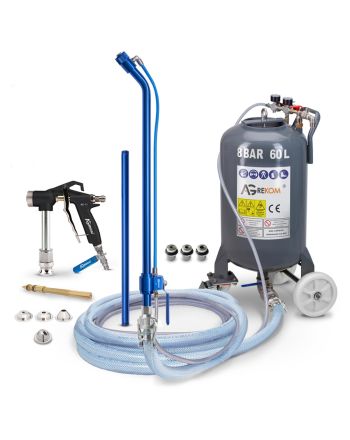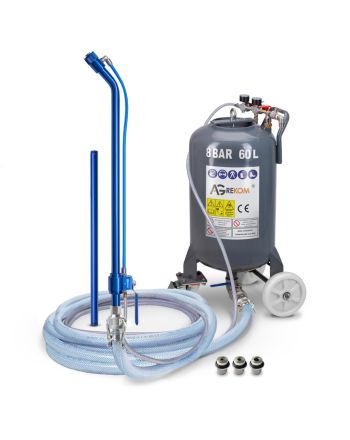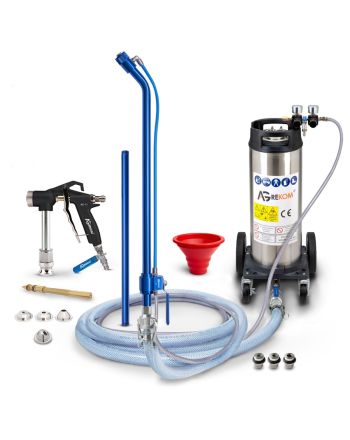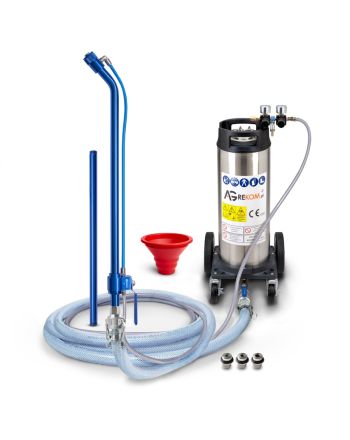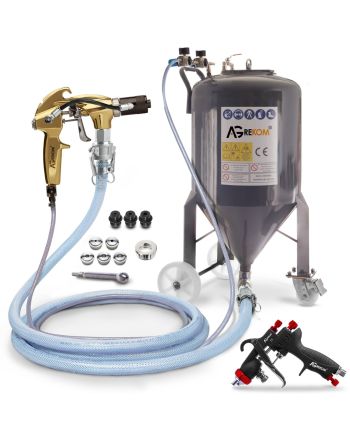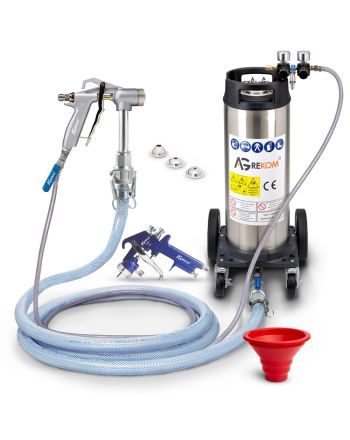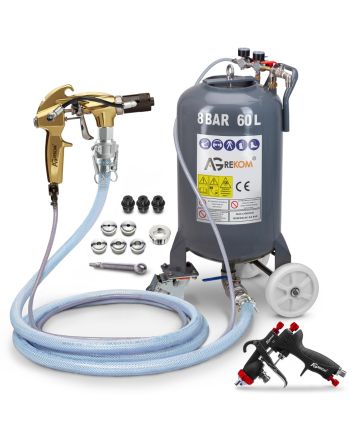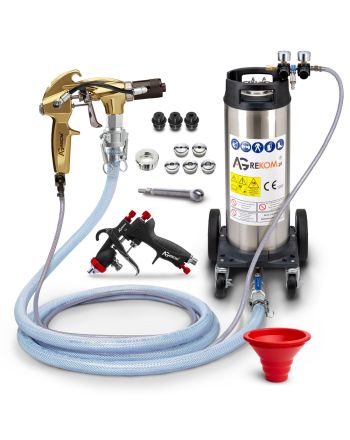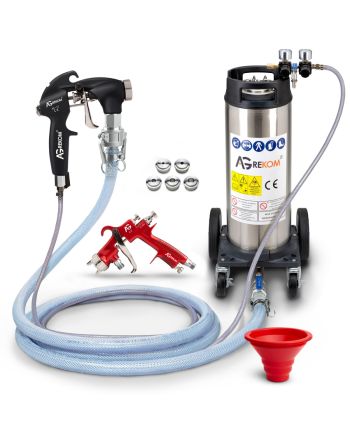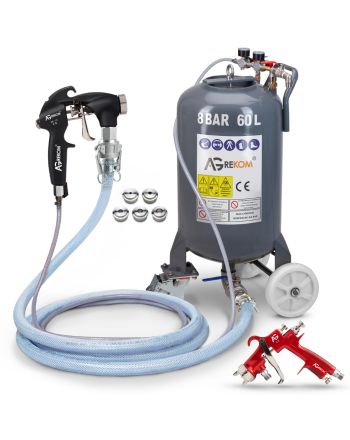PLASTER SPRAY UNITS
(11)WHAT IS A PLASTERING MACHINE?
A plastering unit is a machine that allows the spray application of façade plaster and/or cement-lime plaster. The machine application of plaster is much more efficient compared to the manual method. A suitably selected plastering unit can speed up the work by up to 90%.
PLASTER SPRAY UNITS – WHAT JOBS CAN THEY DO?
Pneumatically powered units help to do many jobs with the use of just one unit. They are most often used for plastering walls, yet their functionality does not stop there. AGREKOM pneumatic plaster spray units are also ideal when spraying structural plaster (sand textured facade plaster), gypsum plaster finish, wall spackle, wall priming with primer contact, and also hydroinsulation of foundations.
Multifunctional mini plaster spray units allow for fast completion of plastering work with the mix covering the walls evenly.
HOW TO CHOOSE THE RIGHT PLASTER SPRAY UNIT?
Choosing the right plaster spray unit is not an easy task. There are a few types of units available on the market that differ in both the way they are powered and in the type of material they work well with.
The once popular silo plaster spray units are starting to be replaced in some jobs by smaller more handy pneumatic units (known as mini units).
Pneumatic plaster spray units are a newie on the market, and thanks to their multi-functionality and mobility, they have gained many satisfied users.
Before buying it, you should ask yourself about what type of piece of equipment you are interested in. There is a choice between professional, semi-professional units, and those for domestic use. The plaster guns are what differs them, and additional components increase the units' efficiency.
It is also worth to take into account the tank size that suits you. AGREKOM plaster spray units come with 2 sizes of tanks: 19 and 60 litres. The larger tank can fit up to 120kg of ready mass. That's why they work really well when plastering large spaces.
The next step is to choose the right length of the technical hoses. They determine the distance we can move away from the tank with the spray gun.
How to plaster with the plaster spray unit?
Before starting any plastering work, you should read the instructions on how to use the unit.
Next you should connect the hoses to the spray gun and the compressor. At first we don’t connect spray gun.
The mix with correct dense that was prepared earlier is ought to be poured into the tank. It is important to note that the tank of the pneumatic unit is not adapted for mixing the plastering mass.
The spraying of the plaster finish should take place with a right length away from the wall. The plaster should be applied in a circular motion. When spraying finish with a flat stream, the spray gun should be moved up the wall in a vertical motion so that the stream of the gun covers the largest area possible in one go.
PLASTERING UNITS ADAPTED TO THE ROOM
When working in rooms that are small in terms of volume, we often have problems choosing the right size of unit. A similar problem arises when we plan to carry out plastering on a very large area. In such situations, not only the capacity, but also the size of the unit is often important.
We offer you plastering units built on the basis of different tank sizes: 19-litre, 20-litre and 60-litre, which differ in both construction and maximum working pressure. This makes it very easy to match the size and capacity of a particular unit to a specific room dimension.
THE PLASTERING UNIT - EASE OF USE IS ESSENTIAL
A plastering unit is the basis for the equipment of every construction company. The plastering unit can be used for spraying materials such as structural plasters, facade plasters, renderings, mesh adhesive and render coatings. Very important in the operation of the device is its simplicity of use and low failure rate. Agrekom units are pneumatically powered. This makes their construction simple and easy to operate. Pneumatic plastering units are also distinguished by their low failure rate.
HOW TO PREPARE A PLASTERING UNIT FOR WORK?
Before spraying, it is essential to read the full or abbreviated operating instructions carefully. This step should not be skipped, as the information contained in the instructions will help you to understand the principle of the unit and thus facilitate its correct connection and start-up.
Before working, it is a good idea to spray the tank of the unit with silicone spray - this will make it easier to drain the material and clean the tank afterwards.
The next step should be the proper connection of the hoses to the tank, as well as the connection of the compressor. Initially, do not connect the spray gun.
Once the mass has been prepared to the correct density, it should be placed in the tank, the compressor switched on and the pressures set according to the plastering unit's instructions. The mass should flow through the line without any problems. At this stage we can already connect the plaster gun. We recommend pouring a small amount of mass through the gun into a bucket before starting work. This will ensure that the mass is homogeneous in both the hose and the gun.
Once the machine has been properly prepared, we can proceed to spray the mass onto the wall.
The plaster or smoothing coat should be sprayed with appropriate distance from the wall. Apply the plaster in a circular motion. When spraying plaster with a flat spray fan, move the gun horizontally in relation to the wall, so that the spray fan covers as much area as possible at once.
The unit should be cleaned after work is completed. To do this, simply fill the tank with water and start the unit. Under pressure, the water will remove any remaining material from the lines, tank and gun.
HOW MANY PEOPLE ARE NEEDED TO OPERATE THE PLASTERING UNIT?
One person is sufficient to operate the Agrekom plastering unit. The unit does not require much work to start up. All you have to do is fill the tank, set the right pressure and spray the plaster with the gun.
HOW TO CLEAN THE PLASTERING MACHINE?
Cleaning the plastering unit is essential. It should be carried out every time after the work has been carried out. The unit is cleaned using a pressure washer. The hoses of the plastering unit can be cleaned by running water through them. Dried residues of building materials can be removed with a sponge.

